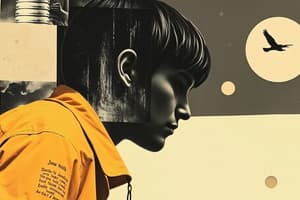Podcast
Questions and Answers
What is a characteristic of categorical variables?
What is a characteristic of categorical variables?
- They can take numerical values.
- They are always created from quantitative variables.
- Their values fall into groups or categories. (correct)
- They have a continuous range of values.
What is the primary purpose of a two-way contingency table?
What is the primary purpose of a two-way contingency table?
- To display the distribution of a single variable.
- To analyze the average of numerical data.
- To summarize relationships between two categorical variables. (correct)
- To compute statistical relevance.
Which of the following best describes marginal distributions?
Which of the following best describes marginal distributions?
- They show the relationship between two variables.
- They summarize each variable independently. (correct)
- They include only the totals of data.
- They are irrelevant to categorical data analysis.
Which of the following statements is true regarding conditional distributions?
Which of the following statements is true regarding conditional distributions?
What does it indicate if the conditional distributions are nearly the same for each category?
What does it indicate if the conditional distributions are nearly the same for each category?
In a two-way contingency table, what type of variables are typically represented?
In a two-way contingency table, what type of variables are typically represented?
Which method is commonly used to visually represent conditional distributions?
Which method is commonly used to visually represent conditional distributions?
What is a potential issue when analyzing marginal distributions?
What is a potential issue when analyzing marginal distributions?
When constructing a two-way contingency table, which of the following is necessary?
When constructing a two-way contingency table, which of the following is necessary?
Which categorical variable example illustrates a potential grouping from a quantitative variable?
Which categorical variable example illustrates a potential grouping from a quantitative variable?
What is Simpson’s Paradox?
What is Simpson’s Paradox?
What role do lurking variables play in Simpson's Paradox?
What role do lurking variables play in Simpson's Paradox?
In the medical helicopter example, what was found regarding survival rates in serious accidents?
In the medical helicopter example, what was found regarding survival rates in serious accidents?
Why is it important to consider subgroup effects when interpreting data?
Why is it important to consider subgroup effects when interpreting data?
What does it mean when a conditional distribution shows significant differences?
What does it mean when a conditional distribution shows significant differences?
What type of data does Simpson’s Paradox primarily relate to?
What type of data does Simpson’s Paradox primarily relate to?
What is a potential consequence of failing to account for lurking variables?
What is a potential consequence of failing to account for lurking variables?
How does subgroup analysis affect the overall interpretation of data regarding medical transport methods?
How does subgroup analysis affect the overall interpretation of data regarding medical transport methods?
Which statement is true about the survival rates and transport methods in the example given?
Which statement is true about the survival rates and transport methods in the example given?
What happens to the apparent relationship between variables when subgroups are combined under Simpson’s Paradox?
What happens to the apparent relationship between variables when subgroups are combined under Simpson’s Paradox?
Flashcards are hidden until you start studying
Study Notes
Categorical Variables: Two-Way Contingency Table
- A two-way contingency table is used to analyze categorical data by summarizing counts or percentages of individuals that fall into various categories.
- Each cell in the table represents the number or percentage of observations falling into a specific combination of categories.
Marginal Distributions
- Marginal distributions show the distribution of each variable separately, ignoring the other variable.
- The percentages in each distribution should sum up to 100%.
Conditional Distributions
- Conditional distributions show the distribution of one variable for a specific value of the other variable.
- For example, the conditional distribution of age for those living in their own place would show the age distribution of only those who live in their own place.
Simpson's Paradox
- Simpson's paradox happens when a trend appears in several different groups of data, but disappears or reverses when these groups are combined.
- This reversal occurs due to a lurking variable that creates subgroups within the data.
- For example, a trend in the survival rate of accident victims transported by helicopter might be reversed when considering the severity of the accidents, revealing differences in survival rates between subgroups based on accident severity.
Studying That Suits You
Use AI to generate personalized quizzes and flashcards to suit your learning preferences.




